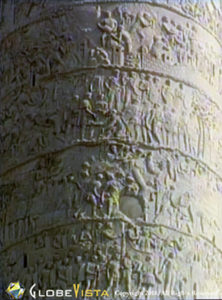
Emperor Trajan
Trajan (Tranjanus) was a Roman Emperor from AD 98-117 and his reign was known as the golden age. After defeating the Dacians (now Romania) he worked on improving the city of Rome’s infrastructure, initiating the draining of the Pontine marshes, improving seaports and reducing taxes. Trajan was the first Roman Emperor not to be born in Italy. He was born in a city in south-eastern Spain near Seville.
The Trajan’s column
Trajan’s Column was erected in AD133, in honour of the Roman Emperor. The spiraling reliefs depict Trajan’s victories in the two Dacian Wars (101-102 & 105-106). The column is meant to be read from the base up, with the lower half depicting the first of the wars and the upper half depicting the second. If you look closely you will see the two sections are divided by a personification of Victory writing on a shield.
Many of the reliefs depict scenes of the Roman army in battles and Romans building fortifications. No wonder the column was once believed to be a propagandistic monument, Emperor Trajan appears about 59 times on the column and is often seen delivering speeches to his troops. However, today many historians now believe the column was used as a measuring guide for the construction of the Roman Forum and not a glorified monument to a victorious emperor.

All in all, there are over 2,500 carved figures on the 30m (98ft) Carrara marble shaft. The shaft is made up of 18 marble drums which each weigh about 40 tons. The frieze winds around the shaft 23 times. The inscription at the base of the column claims that the column was built to be as tall as the hill that was originally there. The column is also the best example of Roman Square Capitals, which is a script often used for stone monuments. A point of note, in 1989, Carol Twombly , created a computer typeface called “Trajan”, which she based on the Trajan column lettering.
Inside the column is a 185 step, spiral staircase leading to a viewing platform. Interestingly upon Trajan’s death in AD 117, his ashes (and his wife Potina) were buried at the base of the column in a golden urn. Now before you decide to go digging around its base, the ashes have long gone!
A statue of an eagle originally stood on the large pedestal atop of the column but was later replaced by a statue of Trajan. In 1588, Pope Sixtus V replaced Trajan with a statue of St Peter, which still stands on the pedestal today.
